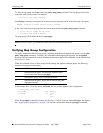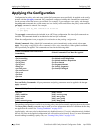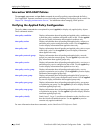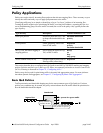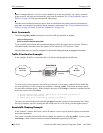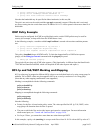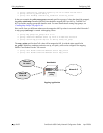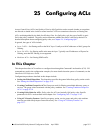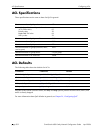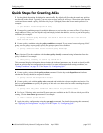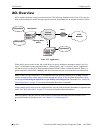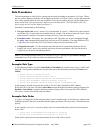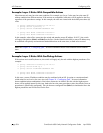
OmniSwitch 6600 Family Network Configuration Guide April 2006 page 25-1
25 Configuring ACLs
Access Control Lists (ACLs) are Quality of Service (QoS) policies used to control whether or not packets
are allowed or denied at the switch or router interface. ACLs are sometimes referred to as filtering lists.
ACLs are distinguished by the kind of traffic they filter. In a QoS policy rule, the type of traffic is speci-
fied in the policy condition. The policy action determines whether the traffic is allowed or denied. For
detailed descriptions about configuring policy rules, see Chapter 24, “Configuring QoS.”
In general, the types of ACLs include:
• Layer 2 ACLs—for filtering traffic at the MAC layer. Usually uses MAC addresses or MAC groups for
filtering.
• Layer 3/4 ACLs—for filtering traffic at the network layer. Typically uses IP addresses or IP ports for
filtering; note that IPX filtering is not supported.
• Multicast ACLs—for filtering IGMP traffic.
In This Chapter
This chapter describes ACLs and how to configure them through the Command Line Interface (CLI). CLI
commands are used in the configuration examples; for more details about the syntax of commands, see the
OmniSwitch CLI Reference Guide.
Configuration procedures described in this chapter include:
• Setting the Global Disposition. The disposition specifies the general allow/deny policy on the switch.
See “Setting the Global Disposition” on page 25-8.
• Creating Condition Groups for ACLs. Groups are used for filtering on multiple addresses, ports, or
services. The group is then associated with the policy condition. See “Creating Condition Groups For
ACLs” on page 25-10.
• Creating Policy Rules for ACLs. Policy rules for ACLs are basically QoS policy rules. Specific
parameters for ACLs are described in this chapter. See “Configuring ACLs” on page 25-10.
• Using ACL Security Features. Specific port group, action, service group, and policy rule combina-
tions are provided to help improve network security. See “Using ACL Security Features” on
page 25-17.



